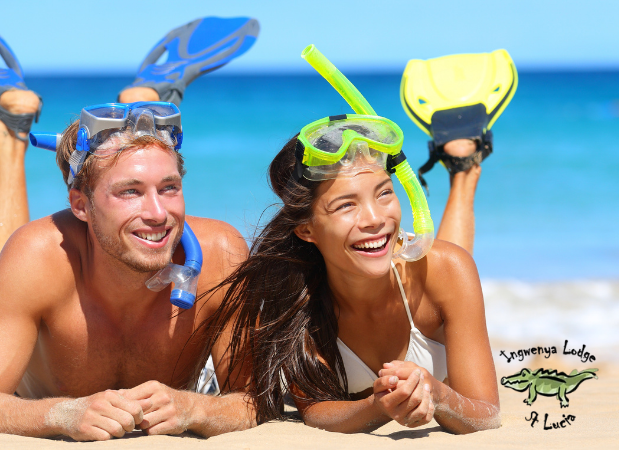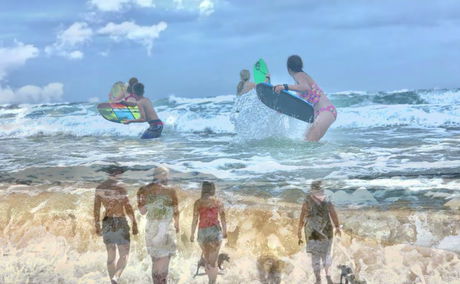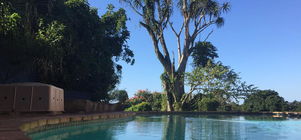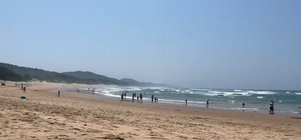December in St Lucia is full for a reason. Families travel from all over South Africa, cars line the streets, and every beach day feels like a shared event. It's festive, busy, and for many people, exactly what they want. But once the Christmas rush fades, something else happens. January arrives quietly – and St Lucia changes pace. The same warm ocean. The same green summer landscape. The same wildlife moving through...
Sodwana Bay – Coral Reefs, Warm Waters & Laid-Back Coastal Vibes

There’s no quick shortcut to Sodwana Bay. It lies within the iSimangaliso Wetland Park – a UNESCO World Heritage Site that begins at St Lucia, its most southern point – and getting there is a journey in itself. It’s a good two-hour drive north, through villages, past fields where goats graze, and under wide, open skies. By the time the road narrows and the forested dunes begin to appear, you’ve already slowed down a little – and that’s exactly the point.
Sodwana isn’t polished or packaged. It’s a small, weathered place with hand-painted signs, dive shops that smell of salt and neoprene, and a scattering of beach cafés where you can get a plate of fish straight off the braai. Out there, just past the breakers, lies one of the world’s southernmost coral reef systems – a living kaleidoscope of fish, corals, rays and turtles. People come for the diving and snorkelling, yes, but they also come for the feeling of it. The easy, sandy pace. The kind of day that ends with salt on your skin and nowhere in a hurry to be.
And even if you never touch a mask or fins, there’s plenty in it for you – long walks on clean, soft sand, the sound of the surf in your ears, and that endless blue that makes you want to linger a little longer. It’s one of the highlights in our guide to the 10 Best Day Trips from St Lucia – a chance to trade forest and estuary views for a full day of Indian Ocean blues.
Why Sodwana Bay Is Worth the Drive
Part of the magic of a day trip is that sense of going somewhere different – and Sodwana delivers on that in spades. Two hours up the coast and you’re in a place that feels nothing like the easy bustle of St Lucia. Life here is stripped back. There are no big hotels or crowds, just a handful of rustic dive shops, weathered cafés, and a beach that seems to stretch on forever.
It’s not fancy. The roads get sandy as you get closer, and the hand-painted signs pointing the way to “Dive Centre” or “Fresh Fish” feel like they belong to another era. That’s part of its charm. The pace slows. People stop to talk, bare feet are the norm, and the days revolve around the sea and the sky. Even if you’re not a diver, it’s the kind of spot that reminds you what a coastal day should feel like – warm, unhurried, and a little wild around the edges and unlike Cape Vidal, this is a stretch where the road ends in sand and reef rather than a mix of bush and bay..
What You’ll See Underwater – Coral Reefs & Marine Life
Step off the sand and into the water here, and it’s like opening the door to a different world. Sodwana Bay is famous for having one of the most southern coral reef systems on the planet – a chain of reefs that glow with colour in the clear, warm water.
Even on a simple snorkel, you’ll see schools of butterflyfish and parrotfish flickering past, green turtles drifting lazily in the swell, and the occasional ray hiding in the sand. For divers, there’s more – pinnacles and caves, hard and soft corals in every shade, and over a thousand recorded species of fish. In winter, when the water cools slightly and visibility sharpens, the ocean gets busy: dolphins sweep through, humpback whales pass just beyond the reef, and if you’re lucky, a whale shark might cruise by.
It’s wild, but it’s also accessible. Whether you’re strapping on a tank with a guide or just sticking close to the shallows with a mask and fins, the reefs at Sodwana feel alive in a way that makes you forget how far you’ve travelled to get here.
Things to Do Beyond the Reef
Sodwana Bay isn’t only about what lies beneath the surface. Even if you never get your feet wet, there’s plenty to fill a day here. The beach itself is wide and long – the kind of sand that squeaks under your feet – and a simple walk can feel like you’ve got the whole coast to yourself.
From June to November, the horizon is often dotted with whale spouts. Local operators launch small boats through the surf to take visitors closer, and there’s nothing quite like watching a humpback breach in that big, empty stretch of sea.
Photographers and birders find their own rhythm here. The edges of the dunes are alive with kingfishers and bee-eaters, and out on the water you’ll see gannets diving for fish. When you’ve had enough sun, there are a few beach cafés and shisa nyama spots where the seafood is fresh and the menu is as simple as the setting.
How to Get There from St Lucia
Getting to Sodwana Bay is part of the adventure. From St Lucia it’s roughly 130 kilometres – just over two hours if you leave early. The road carries you north past sugarcane fields and small rural homesteads, with long stretches where the sky seems to touch the land.
As you get closer, the tar gives way to patches of gravel and sand. The last few kilometres slow you right down, winding through forested dunes before the road suddenly opens up and all you can see is blue. You don’t need a 4x4 unless you plan to explore further up the coast, but the drive rewards an unhurried pace.
Most people make a full day of it – a slow trip up in the morning, time for a dive or a few hours on the beach, and then a relaxed drive back in the late afternoon. By the time you roll back into St Lucia, you feel like you’ve been away far longer than a day.
Insider Tips for Your Day Trip
A few small things can make a big difference on this trip. If you can, aim to arrive early – the sea is calmer in the morning, the light is softer, and you’ll have more time to enjoy the reefs before the wind picks up in the afternoon.
June to November is whale season, so if that’s on your list, this is the time to go. Bring a hat, plenty of drinking water, reef-safe sunscreen and, if you prefer your own gear, a mask and snorkel. There are dive shops where you can hire equipment, but it’s always good to be prepared.
If you’re an early riser, consider stopping at Lake Sibaya on the way. The lake lies just inland from the coast and is worth an hour or two for its stillness and birdlife before you head back to the surf.
Sodwana is simple and low-key, so don’t expect big shops or supermarkets. Stock up on snacks and fuel in advance, then let the day run at its own pace.
Plan Your Day and Make It Yours
A day at Sodwana Bay is different from the other trips along this coastline. It’s a little wilder, a little quieter, and it stays with you long after you’ve brushed the last grains of sand from your shoes. Whether you spend it underwater on the reefs, walking for miles on the open beach, or just watching the horizon, it’s the sort of place that reminds you why you came to this corner of KwaZulu-Natal in the first place.
Back at Ingwenya Lodge in the late afternoon, it becomes part of the rhythm – one more story in a trip that can just as easily include a drive through Hluhluwe-iMfolozi Park or a slow morning along the estuary. If Sodwana Bay sounds like your kind of day, you’ll find it – and plenty more like it – in our full guide to the 10 Best Day Trips from St Lucia.
Further Reading
Evenings in St Lucia have a certain rhythm. The air is warm, the sea hums just beyond the estuary, and somewhere along the coast, the first leatherback turtle hauls herself out of the surf. From the deck at Ingwenya Lodge, guests often watch the sky darken and know that, down the beach, one of the ocean’s oldest rituals is beginning.
Ingwenya Lodge is a family-run self-catering lodge on the outskirts of St Lucia, nestled against the iSimangaliso Wetland Park (South Africa's first UNESCO World Heritage Site). The lodge's six units each have fully equipped kitchens and modern comforts, and the property offers panoramic views of both the St Lucia estuary and the Indian Ocean. The setting is tranquil – hippos often graze on the lawns at night – giving guests a genuine...







Share This Post